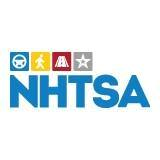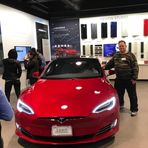Tesla's Robotaxi Rollout: A Bold Step or a Risky Gamble?
June 24, 2025, 6:01 pm

Location: United States, District of Columbia, Washington
Employees: 501-1000
Founded date: 1970

Location: United States, Texas, Austin
Employees: 10001+
Founded date: 2003
Total raised: $3.86B

Location: United States, California, Mountain View
Employees: 1001-5000
Founded date: 2009
Total raised: $19.17B
Tesla has launched its long-awaited robotaxi service in Austin, Texas. This move marks a significant milestone for the company, but it also raises questions about safety, technology, and competition. The service, which began on June 23, 2025, features a small fleet of modified Model Ys. These vehicles operate without a driver, relying solely on Tesla's camera-based self-driving technology.
The rollout is limited. The robotaxis navigate geo-fenced neighborhoods, avoiding complex intersections and airports. A Tesla safety employee sits in the passenger seat, ready to intervene if necessary. This cautious approach reflects the company’s need to balance innovation with safety.
Initial rides cost $4.20, a price point that appeals to budget-conscious riders. Early reports from influencers show smooth rides, but the service is still in its infancy. Tesla has only deployed 10 to 20 vehicles, operating under tightly controlled conditions.
Investors reacted positively, with Tesla's shares rising in pre-market trading. Analysts see potential in Tesla's vision-only approach. If successful, it could provide a significant cost advantage over competitors like Waymo, which relies on lidar and radar. RBC Capital Markets estimates that autonomy could account for 60% of Tesla's long-term valuation.
However, the launch comes amid increasing regulatory scrutiny. Texas Governor Greg Abbott recently signed a law requiring autonomous vehicle operators to obtain DMV permits before removing human drivers. This law takes effect on September 1, adding another layer of complexity to Tesla's plans.
Federal regulators are also keeping a close eye on Tesla. The National Highway Traffic Safety Administration (NHTSA) is investigating the company’s claims about its autopilot and full self-driving capabilities. A letter sent in May requested more details about the robotaxi's safety architecture.
Tesla's reliance on cameras sets it apart from competitors. Waymo uses a combination of cameras, radar, and lidar to navigate. This multi-faceted approach allows for better performance in challenging conditions, such as low light or rain. Tesla argues that its camera-only system is cheaper and easier to scale. But this strategy comes with risks.
The Austin launch is a test. It’s a small-scale pilot, and many questions remain. Forrester VP analyst Paul Miller describes it as a “low-key” launch. He warns that if Tesla's full self-driving system doesn’t show significant improvement, the company may need an army of remote operators. This could increase costs and create reputational risks.
Competitors are already ahead. Waymo has completed over ten million driverless rides in cities like Phoenix and San Francisco. Its vehicles operate without any in-car safety monitor, showcasing a level of confidence that Tesla has yet to achieve.
Tesla's future plans include a new “cyber cab,” designed specifically for autonomy. This vehicle will have no pedals or steering wheel and is expected to cost under $30,000. Musk envisions deploying up to 1,000 robotaxis in the coming months, with expansions planned for San Francisco and Los Angeles.
But catching up to Waymo won’t be easy. Barclays analyst Dan Levy notes that building the necessary infrastructure for full autonomy—both physically and legally—will take time. Tesla faces hurdles on multiple fronts, from regulatory compliance to technological advancement.
Early customer experiences have been mixed. Videos shared online show instances where Tesla's robotaxis violated traffic laws. Some vehicles exceeded speed limits, while others entered restricted lanes. These incidents raise concerns about the reliability of the self-driving technology.
The NHTSA has opened multiple probes into Tesla's autonomous driving software. These investigations stem from crashes involving Tesla vehicles with the software enabled. The scrutiny could complicate Tesla's plans for its robotaxi service.
Despite the challenges, some analysts remain optimistic. Wedbush analysts, who experienced the service firsthand, described it as “safe, comfortable, and personalized.” They view the launch as the beginning of Tesla's ambitious journey into AI and autonomous driving.
In conclusion, Tesla's robotaxi launch is a bold step into uncharted territory. The company is betting on its data advantage and innovative technology. But the road ahead is fraught with challenges. Regulatory hurdles, safety concerns, and competition from established players like Waymo loom large.
As Tesla navigates this complex landscape, the world will be watching. Will it succeed in redefining transportation, or will it face setbacks that could derail its ambitions? Only time will tell. For now, the robotaxi service is a small but significant piece of a much larger puzzle. The future of autonomous driving hangs in the balance, and Tesla is at the forefront of this revolution.
The rollout is limited. The robotaxis navigate geo-fenced neighborhoods, avoiding complex intersections and airports. A Tesla safety employee sits in the passenger seat, ready to intervene if necessary. This cautious approach reflects the company’s need to balance innovation with safety.
Initial rides cost $4.20, a price point that appeals to budget-conscious riders. Early reports from influencers show smooth rides, but the service is still in its infancy. Tesla has only deployed 10 to 20 vehicles, operating under tightly controlled conditions.
Investors reacted positively, with Tesla's shares rising in pre-market trading. Analysts see potential in Tesla's vision-only approach. If successful, it could provide a significant cost advantage over competitors like Waymo, which relies on lidar and radar. RBC Capital Markets estimates that autonomy could account for 60% of Tesla's long-term valuation.
However, the launch comes amid increasing regulatory scrutiny. Texas Governor Greg Abbott recently signed a law requiring autonomous vehicle operators to obtain DMV permits before removing human drivers. This law takes effect on September 1, adding another layer of complexity to Tesla's plans.
Federal regulators are also keeping a close eye on Tesla. The National Highway Traffic Safety Administration (NHTSA) is investigating the company’s claims about its autopilot and full self-driving capabilities. A letter sent in May requested more details about the robotaxi's safety architecture.
Tesla's reliance on cameras sets it apart from competitors. Waymo uses a combination of cameras, radar, and lidar to navigate. This multi-faceted approach allows for better performance in challenging conditions, such as low light or rain. Tesla argues that its camera-only system is cheaper and easier to scale. But this strategy comes with risks.
The Austin launch is a test. It’s a small-scale pilot, and many questions remain. Forrester VP analyst Paul Miller describes it as a “low-key” launch. He warns that if Tesla's full self-driving system doesn’t show significant improvement, the company may need an army of remote operators. This could increase costs and create reputational risks.
Competitors are already ahead. Waymo has completed over ten million driverless rides in cities like Phoenix and San Francisco. Its vehicles operate without any in-car safety monitor, showcasing a level of confidence that Tesla has yet to achieve.
Tesla's future plans include a new “cyber cab,” designed specifically for autonomy. This vehicle will have no pedals or steering wheel and is expected to cost under $30,000. Musk envisions deploying up to 1,000 robotaxis in the coming months, with expansions planned for San Francisco and Los Angeles.
But catching up to Waymo won’t be easy. Barclays analyst Dan Levy notes that building the necessary infrastructure for full autonomy—both physically and legally—will take time. Tesla faces hurdles on multiple fronts, from regulatory compliance to technological advancement.
Early customer experiences have been mixed. Videos shared online show instances where Tesla's robotaxis violated traffic laws. Some vehicles exceeded speed limits, while others entered restricted lanes. These incidents raise concerns about the reliability of the self-driving technology.
The NHTSA has opened multiple probes into Tesla's autonomous driving software. These investigations stem from crashes involving Tesla vehicles with the software enabled. The scrutiny could complicate Tesla's plans for its robotaxi service.
Despite the challenges, some analysts remain optimistic. Wedbush analysts, who experienced the service firsthand, described it as “safe, comfortable, and personalized.” They view the launch as the beginning of Tesla's ambitious journey into AI and autonomous driving.
In conclusion, Tesla's robotaxi launch is a bold step into uncharted territory. The company is betting on its data advantage and innovative technology. But the road ahead is fraught with challenges. Regulatory hurdles, safety concerns, and competition from established players like Waymo loom large.
As Tesla navigates this complex landscape, the world will be watching. Will it succeed in redefining transportation, or will it face setbacks that could derail its ambitions? Only time will tell. For now, the robotaxi service is a small but significant piece of a much larger puzzle. The future of autonomous driving hangs in the balance, and Tesla is at the forefront of this revolution.